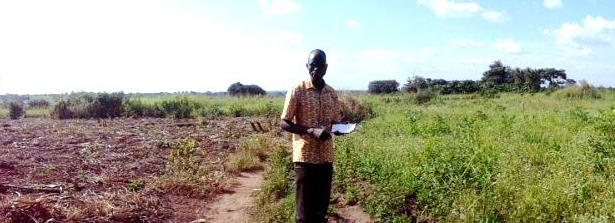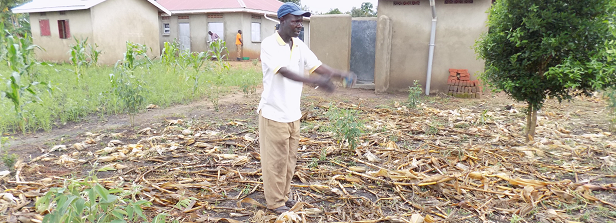Farmer-led soil innovations to sustain food production in Uganda

Duration: July 2014 – July 2017. This project has been finalized.
Project information
Aim: Establish the relationship between promising initiatives in the domain of Conservation Agriculture, the productivity of the farming systems and the sustainability and resilience of its land management; identify and develop methods for improving the effectiveness, sustainability and resilience of the local Conservation Agriculture initiatives; pursue capacity building trajectories for extension services and incorporate best methods in the farmer support and dissemination mechanisms.
Objective: Combat food insecurity for rural households.
Method: Participatory on-farm field testing, evaluations and fine-tuning with local farmers.
Country: Uganda
Dutch policy goal: Increase sustainable food production.
Progress reports
Year 1: Conservation farming practices initiated by individual farmers in Northern Uganda have the potential to prevent further nutrient depletion of the agricultural land. The most promising initiatives will be optimized and promoted further to achieve optimal soil fertility management and achieve a more sustainable farming system.
Year 2: To prevent further nutrient depletion in Northern Uganda, the research team first organized a stakeholder workshop in Nwoya district in August 2014. During this event, government officials, practitioners and members of the farming community were introduced to the principles of Conservation Farming (CA), a way of farming that minimalizes soil disturbance. After the workshop and a radio broadcast about the project, the team started with participatory mapping of existing Conservation Agricultural initiatives. The farming practices of 190 innovative farmers in Nwoya and Pader district were categorized according to the major CA principles of minimum soil disturbance, crop combinations, the use of agro inputs and soil and water conservation.
Pilot farmers
The project team then selected 65 pilot farmers. Detailed household data were collected from these farmers including farm characteristics, fertility perception, cropping history and labor and input costs. The highest yielding, the lowest yielding and the most intensively used plots were selected for soil sample analysis. After having analyzed the household data and the soil samples, the team discussed the findings with the pilot farmers and governmental officials in an innovation workshop in Nwoya, in May 2015. Here valuable practices were defined, including the use of a wide array of cover crops (for example soybean, cassava or groundnuts), intercropping and the use of banana stems or grass strips to promote infiltration of runoff. Remarkable was the finding that the conversion of a productive plot in fallow was equally triggered by excessive prevalence of weeds than by reduced soil fertility.
Groundnut and beans
The participants selected groundnut, maize and beans as study crops for the first trial experiments. They also defined the demo package: only slashing, herbicide spraying, single tillage and sowing. So the pilot farmers received a spray pump and access to glyphosate herbicides. The team introduced herbicide application during a technical training course, and the field staff visited the farmers every two weeks. Additionally, the team organized a focus group discussion per sub county to allow farmer to farmer interaction on the demo package. In this way, the project uses a step wise approach to introduce the different elements of Conservation Agriculture.
Final report
Summary of the results: For technology adoption, farmers need to be involved in the testing. This is exactly what the project allowed in relation to the three core aspects of Conservation Agriculture – zero tillage, crop rotation and continuous ground cover. The project identified 106 (75M, 31F) model farmers in the districts of Pader, Nwoya and Nebbi, Uganda. It built their capacity to carry out on-farm experimentation and “farmer to farmer” extension. Each model farmer had their soils tested and were then asked to list characteristics of a “good”, “moderate” and “poor” field in regard to soil fertility. This farmer indigenous knowledge was then compared with the lab assessment and a visual soil fertility classification tool was developed. As part of “Zerotillage” the use of glyphosate was promoted. This was popular with farmers and found to be cost effective due to labour savings for cultivation and weeding (3x’s to 1x’s). The technology spread quickly to the neighbours of model farmers. The trash left after spraying was an effective mulch and climate change impacts were reduced. Innovation was encouraged and farmers tested a number of new ideas in regard to conservation agriculture. The model farmers have become a focal point for farmer learning in their communities.

